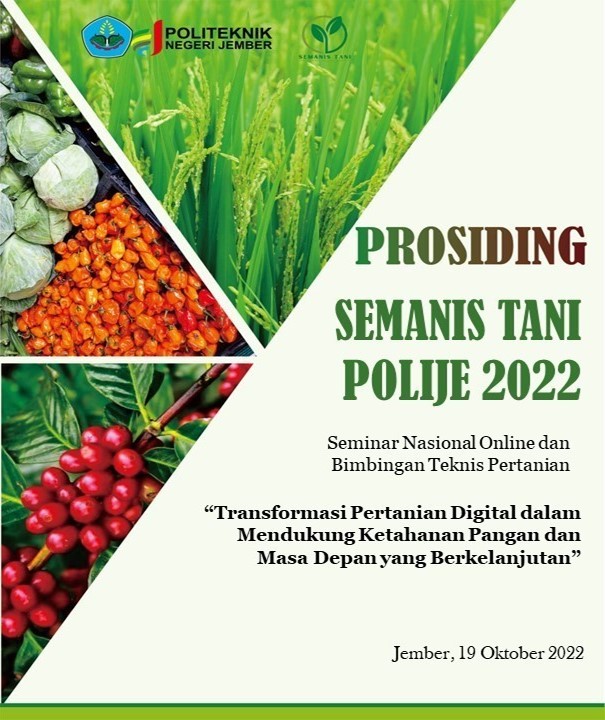PEMANFAATAN LIMBAH AIR KELAPA UNTUK MENINGKATKAN AKUMULASI FOTOSINTAT DAN LUAS DAUN BIBIT KAKAO (Theobroma cacao L.)
DOI:
https://doi.org/10.25047/agropross.2022.284Kata Kunci:
Cocoa seedling, Coconut water, Dry weight, Liquid EffluentAbstrak
Indonesia is one of the cocoa producers in the world, but Indonesia's cocoa production is still below the Ivory Coast and Ghana. One of the ways to increase production is by using good seeds. Good seeds can be obtained with optimal maintenance. Through the use of coconut water as waste containing nutrients and growth hormones, it is expected to increase growth components such as dry weight and leaf area. Good seeds when planted in the field will produce well too. The experiment was carried out in April – August 2021, in the Ciparanje experimental garden, Faculty of Agriculture, Padjadjaran University, Jatinangor with an altitude of 725-800 masl. The experiment used a Randomized Block Design (RAK) with ten treatment combinations and was repeated three times, each treatment consisting of four plants. The treatments tested were control, urea 2 g/polybag, administration of coconut water through plants at 100%, 75%, and 50% calibration doses, administration of coconut water through soil 100%, 75%, and 50% dose of field capacity, administration of coconut water. through plants 25% calibration dose + through soil 25% dose field capacity, and giving coconut water through plants 50% calibration dose + through soil 50% dose field capacity. The experimental results showed that the best response on dry weight and leaf area of cocoa seedlings was caused by giving coconut water through plants with 50% calibration dose.
Unduhan
Referensi
Amsyahputra, A. Adiwirman, & Nurbaiti. (2016). Pemberian berbagai konsentrasi air kelapa pada bibit kopi robusta (Coffea canephora Pierre). Jurnal Online Mahasiswa Faperta. Vol 3(2): 1-12.
Anastasia, I., M. Izzati, & S. W. A. Suedy. (2014). Pengaruh pemberian kombinasi pupuk organik padat dan organik cair terhadap porositas tanah dan pertumbuhan tanaman bayam (Amarantus tricolor L.). Jurnal Akademika Biologi. Vol 3(2): 1-10.
Darlina, Hasanuddin, & H. Rahmatan. (2016). Pengaruh penyiraman air kelapa (Cocos nucifera L.) terhadap pertumbuhan vegetatif lada (Piper nigrum L.). Jurnal Ilmiah Mahasiswa Pendidikan Biologi. Vol 1(1): 20-28.
Elidar, Y. (2018). Pertumbuhan bibit kakao (Theobroma cacao L.) pada pemberian dosis dan interval pupuk organik cair nasa. Jurnal Agriment. Vol 3(1): 1-6.
ICCO. (2022). ICCO Quarterly Bulletin of Cocoa Statistics Vol. XLVIII, No 1, Cocoa year 2020/2021.https://www.icco.org/wp-content/uploads/Production_QBCS-XLVIII-No.-1.pdf. Diakses tanggal 8 April 2022
Kurniawati, D., H. R. A. Mulyani, & R. Noor. (2020). Penambahan larutan bawang merah (Allium cepa L.) dan air kelapa (Cocos nucifera L.) sebagai fitohormon alami pada pertumbuhan tanaman tebu (Sacchanum officinarum L.) sebagai sumber belajar biologi. Jurnal Bioedukasi. Vol 11(2): 160-167.
Mahrizal, M., Syahrir., Suharman., P. Purnomosidhi., J.M. Roshetko. (2013). Panduan budidaya kakao (cokelat) untuk petani skala kecil. Lembar Informasi AgFor 6. Bogor, Indonesia: World Agroforestry Centre (ICRAF) Southeast Asia Regional Program.
Prayoga, F., R. S. Budi, & F. M. Simbolon. (2020). Pengaruh pemberian pupuk organik dan air kelapa terhadap pertumbuhan bibit tanaman aren (Arenga pinnata Merr). Agriland Jurnal Ilmu Pertanian. Vol 8(1): 79-83.
Purwanto, Mujiono dan Tarjoko. (2017). Effect of Foliar Liquid Organic Fertilizer to Increase Coconut Neera Production. Planta Tropika: Jurnal Agrosains (Journal of Agro Science) Vol 5 No 2 . Diakses tanggal 5 April 2022.
Rahmatan, H. (2016). Pengaruh penyiraman air kelapa (Cocos nucifera L.) terhadap pertumbuhan vegetatif lada (Piper nigrum L.). Jurnal Ilmiah Mahasiswa Pendidikan Biologi. Vol 1(1).
Ramdhini, R. N., A. I. Manalu, I. P. Ruwaida, P. L. Isrianto, N. H. Panggabean, S. Wilujeng, & D. R. Surjaningsih. (2021). Anatomi Tumbuhan. Yayasan Kita Menulis.
Ratnasari, Y., N. Sulistyaningsih, & U. Sholikhah. (2015). Respon pertumbuhan bibit kakao (Theobroma cacao L.) terhadap aplikasi berbagai dosis pupuk kascing dengan pemberian air yang berbeda. Jurnal Berkala Ilmiah Pertanian. Hal 1-5.
Rosniawaty, S., Anjarsari, I.R.D., dan Sudirja, R. (2018). Aplikasi sitokinin untuk meningkatkan pertumbuhan tanaman teh di dataran rendah. Jurnal Tanaman Penyegar dan Industri Volume 5 No.1, hal 36-37.
Rosniawaty, S., M. Ariyanti, C. Suherman, R. Sudirja, & S. Fitria. (2021). Utilization of coconut water waste to increase cocoa growth seedling by different application methods and intervals. IOP Conf. Ser.: Earth Environ. Sci. Vol 653(1): 1-7.
Rosniawaty, S., C. Suherman, M. A. Sholeh, R.Sudirja, dan D. N. Annisa. (2020). Akumulasi Bahan Kering dan Indeks Klorofil Bibit Kakao Akibat Aplikasi Air Kelapa dengan Konsentrasi Berbeda. Jurnal Agroekoteknologi 13 (1) : 29 – 38,
Rosniawaty, S., C. Suherman, R. Sudirja, & D. N. A. Istiqomah. (2020). Aplikasi beberapa konsentrasi air kelapa untuk meningkatkan pertumbuhan bibit kakao kultivar ICCRI 08 H. Jurnal Kultivasi. Vol 19(2): 1119-1125.
Rosniawaty, S., M. Ariyanti, C. Suherman, R. Sudirja dan Syfani Fitria. (2021). Pengaruh Aplikasi Air Kelapa Tua dengan Cara dan Interval yang Berbeda terhadap Bobot Kering Bibit Kakao. Jurnal Paspalum. Volume 10 Nomor 1: 1-6
Ruminta, R., Y. Yuwariah, & N. Sabrina. (2017). Respon pertumbuhan dan hasil tanaman hanjeli (Coix lacryma-jobi L.) terhadap jarak tanam dan pupuk pelengkap cair. Jurnal Agrikultura. Vol 28(2).
Unduhan
Diterbitkan
Cara Mengutip
Terbitan
Bagian
Lisensi
Hak Cipta (c) 2022 Santi Rosniawaty, Mochamad Arief Soleh, Mira Ariyanti, Rija Sudirja, Evangelia Br Sitanggang

Artikel ini berlisensi Creative Commons Attribution 4.0 International License.
Hak cipta (Copyright) artikel yang dipublikasikan di Agropross : National Conference Proceedings of Agriculture dipegang oleh penulis (Copyright by Authors) di bawah Creative Commons Attribution 4.0 International License (CC-BY). Sehingga penulis tidak memerlukan perjanjian pengalihan hak cipta yang harus diserahkan kepada redaksi.






